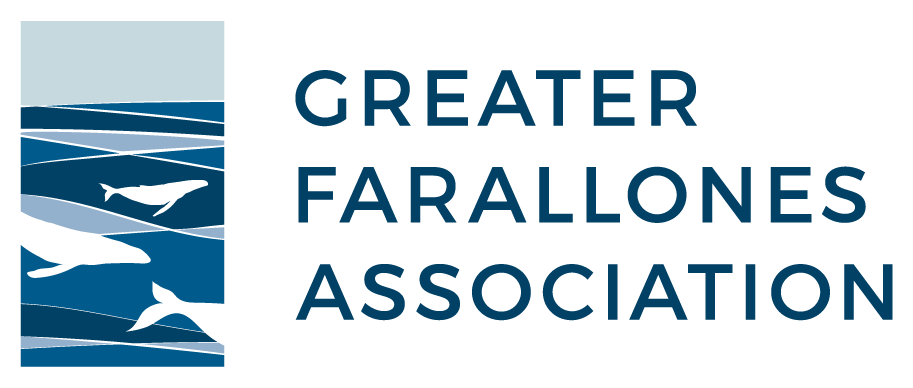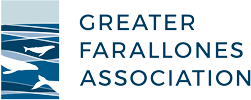FOR IMMEDIATE RELEASE
Greater Farallones Association Releases Plan to Save Bull Kelp Forest
In recent years, over 90% of bull kelp forests along the Sonoma and Mendocino coasts have been lost. Now, the Association and partners are working to recover this important habitat.
SAN FRANCISCO, June 4, 2019 — The Greater Farallones Association released a comprehensive Sonoma-Mendocino Bull Kelp Recovery Plan (the Plan) to address the devastating loss of bull kelp forest along the North-central California coast. The Plan is prepared for the Greater Farallones National Marine Sanctuary (the Sanctuary) and California Department of Fish and Wildlife (CDFW), and will be jointly implemented by the Greater Farallones Association, the Sanctuary, and community partners.
Why do we care?
Kelp forests are an important coastal habitat, providing food and shelter for thousands of marine species, including species important to local fisheries. CDFW reports that since 2014, more than 90% of bull kelp canopy in the Sonoma-Mendocino county region was lost due to a “perfect storm of ecological impacts,” including increased ocean temperatures, harmful algal blooms, and booming populations of kelp predators like purple urchins.
The sea star, sea urchin, kelp connection
Sea stars are a major predator for sea urchins, but beginning in 2013, sea stars along the US West Coast experienced a massive die-off due to a mysterious disease known as ‘sea star wasting syndrome.’ With fewer sea stars predating on them, the purple urchins have flourished, experiencing a population boom, and devouring what were once-resilient bull kelp forests. Where bull kelp once tangled in abundant snarls of brown seaweed from surface to seafloor, we now find water columns nearly devoid of life, and fields of urchins stretched out beneath.
“Between the ravenous and ever-growing purple urchin barrens, the warming ocean temperatures and strange phenomena like the ‘Blob’—which is slowing the process of upwelling and putting a clamp on nutrients in our waters—our normally hearty bull-kelp can’t seem to catch a break,” says Francesca Koe, an avid NorCal diver and co-chair of the recently completed Kelp Recovery Working Group, convened by the Sanctuary’s Advisory Council.
Kelp loss leads to closed fisheries
The loss of bull kelp has led to the decline of two economically-important fisheries: The region’s commercial red urchin fishery has declined by 60-80% and the recreational red abalone fishery (worth $44 million per year in non-market value) was completely closed in 2018. Red urchins, experiencing starvation events due to kelp loss, are outcompeted by purple urchins; while red abalone populations, suffering mass starvation, have sharply declined.
“The good news is, our community has come together to find solutions that facilitate recovery and foster the resilience of bull kelp forest ecosystems. It has been nothing short of inspiring to see and hear Tribes-people, recreational and commercial users, scientists in myriad disciplines, and collaborators from around the world, put forward ideas, projects, and energy to buoy up the kelp,” says Koe.
The Greater Farallones Association’s Bull Kelp Recovery Plan
The Plan includes strategies in the following areas:
-
Restoration site selection, including, but not limited to, consideration for historical levels of kelp, areas previously surveyed and ideal for future monitoring, and areas of cultural significance to local tribes;
-
Active, multi-phase kelp recovery, including, but not limited to, reduction of grazing pressure from kelp predators (e.g., from purple urchins) and planting of kelp spores;
-
Monitoring and research, including systematic, long-term underwater and aerial monitoring of kelp canopy cover and research to inform next steps in recovery and maintenance efforts; and,
-
Community engagement, including efforts to bridge the gap between research and restoration, and motivated community members who are eager to help with active recovery efforts.
Greater Farallones Association is currently seeking funding for next phases of the Bull Kelp Recovery Plan.
________
Learn more: https://farallones.org/kelp/
Support Bull Kelp Recovery: https://farallones.org/donate/
More on the Web:
Farallones.org
Facebook.com/Farallones/
Twitter.com/FarallonesNews/
Instagram.com/farallonesnews/
Related blog: Bull Kelp: What is it and why does it matter?
________
Greater Farallones Association (GFA) is a 501(c)(3) nonprofit that helps conserve, research, and protect the Greater Farallones National Marine Sanctuary, a federally-designated region encompassing 3,295 square miles of coastal waters and open ocean off the California coast. Our mission is to help preserve, monitor, research, educate about, and enhance the Greater Farallones National Marine Sanctuary. Our organization is unique in that every program incorporates local communities in achieving its goals. We engage nearly 14,000 adults and youth per year in our educational programs, and empower citizens to take a hands-on role in monitoring and conserving Sanctuary waters, wildlife, and coastlines. We are committed to high-impact programs rooted in science that provide educational opportunities for our community and protect the environment around us.
Farallones.org
Greater Farallones National Marine Sanctuary
Designated in 1981, Greater Farallones National Marine Sanctuary protects the wildlife and habitats of one of the most diverse and bountiful marine regions in the world, covering 3,295 square miles off the north-central California coast. This extraordinarily rich, diverse, internationally significant ecosystem encompasses marine habitats including open ocean and estuaries, rocky shores, wetlands and sandy beaches. The sanctuary supports major populations of endangered blue and humpback whales, sea lions, and dolphins. It sustains the largest breeding seabird rookery in the contiguous United States, an important population of white sharks, valuable fisheries, marine invertebrates and hundreds of shipwrecks. Through research, education, conservation and stewardship Greater Farallones sanctuary helps ensure these are preserved for future generations.
Farallones.noaa.gov/
###
Contact:
media@farallones.org
Photo Attachment
Photo Caption: A bull kelp forest as seen from the surface of Ocean Cove in Northern California in 2012 and 2016. Kevin Joe and Cynthia Catton, California Department of Fish & Wildlife
Photo Credit: Kevin Joe and Cynthia Catton, California Department of Fish & Wildlife

